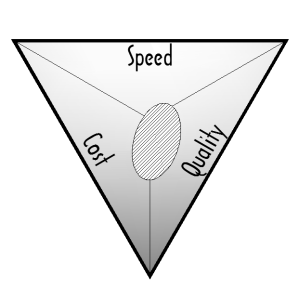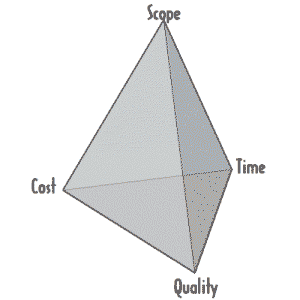Factors Affecting a Project

The Productivity Triangle
The basic premise of a productivity triangle is simply this:
- if you want quality work at low cost, be prepared to spend a little extra time
- if you want quality work, but you want it very quickly, it will cost you a pretty packet
and finally - if you want it quickly and cheap as well, the quality will, most certainly, suffer.
The shaded area in the diagram here is bT Square Peg’s preferred zone for most projects. Quality gets first priority, cost is close behind and time; well that’s important too but experience has shown that haste really does make waste!
The Triangle becomes a Tetrahedron

The Productivity Tetrahedron
Actually, if you want to be really accurate, there is a fourth factor in this equation – the scope of work.
In the triangle above, we’ve assumed the scope of work as constant. This is hardly the case in reality and, in my experience, the scope invariably increases after the work has begun (and after the estimates are made!).
This factor can have a major impact on the schedule as well as the budget so, if the scope of work is increased, one must understand that – to maintain the same quality – the cost as well as the time to completion will increase proportionately.
And That’s Not All Folks
There is one last factor that needs to be looked at; decision-making. People often assume that a few pending decisions can be made at the last minute without affecting a project’s time-line. Not true. A pending decision is like the proverbial joker in a pack of cards–you never know when it will turn up and cannot plan for it. Over the years, the one thing that delays my projects the most–much more than labour problems or availability of materials–is the sentence, “let’s decide that next time”.

